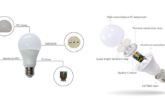Last updated on May 14th, 2025 at 08:46 pm
Ideally, we use lumens as an SI unit for luminous flux. That is, you can use this unit to describe the amount of light falling on surfaces.
It subsequently gauges a light’s apparent brightness to a human eye. That is to say, a one-output candela with an even point source emits 1 lumen of light over a one-steradian solid angle.
Benefits of Knowing Lumen in Lighting Systems
· Energy Savings
By learning about lumens, you may select lighting that uses less energy to achieve the required brightness.
· Accurate Brightness
Lumens are quantifies of the light that a bulb generates, they enable you to compare brightness amongst various lighting items.
· Better Lighting Design
Lumen creates rooms with the correct lighting. For instance, ambient lights in a living room require fewer lumens than task lighting in a kitchen or workplace.
You may also be interested in lighting for bedroom and wattage for outdoor lights.
· Cost Savings
By acquiring just the required bulbs, knowing lumens may help you choose the ideal lighting for your requirements, preventing over- or under-lighting.
· Compliance with Standards
Knowing this metric guarantees compliance with safety and design requirements for different locations. A lot of construction rules and regulations prescribe illumination levels in lumens.
· Longer Product Life
LEDs and other higher-lumen-efficiency bulbs lower the need for frequent replacements and related expenses.
What is Lumen in Lighting Systems?
Lumen is a standard measuring unit for the total amount of visible light coming from the light source.
It gauges how much brightness, or luminous flux, is visible to the human eye in a light bulb or fixture.
The light source brightness increases with the lumen rating.
Converting Lumen into Watts
A light source allows you to estimate the power consumption required to achieve a certain brightness. Approximate Lumens per Watt Conversions in different types of bulbs:
- Lumens per watt for incandescent bulbs: around 10–15
- 60–100 watts per 1000 lumens
- CFLs (compact fluorescent lamps): provide between 40 and 70 lumens per watt.
- About 1000 lumens at 14–25 watts
- LED bulbs: 80–100 lumens per watt
- 10–14 watts per 1000 lumens
Determining Lumen you need to Lighting Home.
In a house, the amount of light depends on the size and purpose of each room.
- Living room: 1,500 to 3,000 lumens
- Kitchen: between 4,000 and 8,000 lm
- Lights in the dining room: 3,000–6,000 lux
- Bedroom: between 2,000 and 4,000 lm
- Bathroom: between 4,000 and 6,000 lm
- Home Office: three to six thousand lumens
- Hallways: between 1,000 and 2,000 lm
Lumen vs. Watts Equivalent
Lumen measures the total illumination visible from a particular bulb.
Watts measures the amount of electrical energy utilized by a light bulb.
How to Calculate Lumen
- Calculate the size of the room by multiplying its width and length.
If the measurements are 12 feet broad and 10 feet long, the room size will be 120 square feet.
- Find out how many footcandles match your application.
The kind of room you are illuminating determines the lights needed.
- Multiply the necessary amount of foot-candles by the square area of the room.
Conclusion
When you have a light fixture with a high lumen count, the brightness in the room will increase because the lumen measures the bulbs’ light intensity.
Activities involving high accuracy or night vision require more lumens, which affects the light fixture you choose.
Knowing the relationship between lumen and wattage will guarantee successful and effective illumination, reducing environmental effects.

